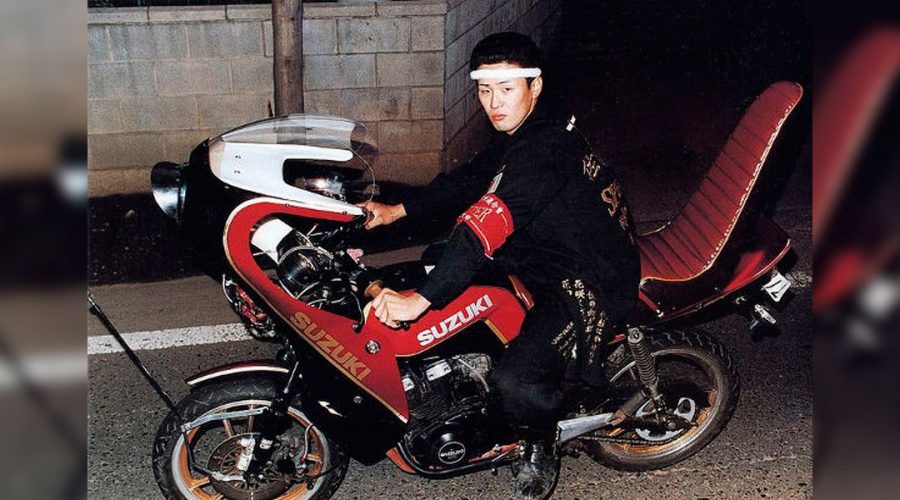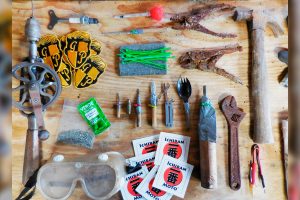Japanese Motorcycle Gangs – Bosozoku!
Bōsōwhaaaat!?
Have you seen Akira? If you have, we could say that the motorcycle gangs in Akira were the Bōsōzoku from future. In the real world the word bōsōzoku is often synonym for illegal motorcycle customization and making a very loud noise by removing the mufflers. The gang members don’t wear motorcycle helmets which is also illegal in Japan, they drive dangerously weaving in traffic, speed in city streets just for the thrill or ride in hundreds very slowly through suburbs at speeds of 7km/h, they wave imperial Japanese flags, they start fight including weapons such as wooden swords, baseball bats or Molotov cocktails, they run red lights… The bike at the head of the group is always driven by the leader, who is responsible for the event and is not allowed to be overtaken. Japanese police call them Maru-Sō 丸走.
Bōsōzoku means “violent speed tribes”, this term was invented by the reporters. These groups aren’t anything like American motorcycle gangs. Today’s bōsōzoku or at least the ones back in the 80’s were still trapped in the days after the WWII. They adopted the style of American rebel teenagers, pompadour hairstyles, leather jackets, knives and other not firing weapons and a hell of a badass attitude.
These bōsōzoku gangs are generally composed of people in between the ages of 16 and 20 (being 20 the legal age in Japan), the years in which you can ride a motorcycle, but not a car. Their anti-anti attitude and lack of respect for authority set them apart from the normal teenager in Japan. Many dedicated members move on to become low ranking members of the yakuza after their 20th birthday. This means that bōsōzoku members, unlike American motorcycle gangs, have never really been adult oriented groups.
The Roots
After WWII and having lived under the assumption of never returning home alive, such as the kamikaze pilots assigned for a mission that never came to be, a big part of the war veterans returned with plenty of difficulties and post-war syndromes. These individuals needed to escape these thoughts and feel part of the game again so they started looking for new excitement by conducting less than desired, gang type activities on city streets. Inspiration was found in foreign movies such as Rebel Without Cause (1955), same as idols, James Dean.
All these ingredients caught the motorcycle obsessed youth and the precursors to the bōsōzoku started popping up, they were known as kaminari zoku 雷族 or “Thunder Tribe”. Most bōsōzoku members came from the lower classes and may have used the motorcycle gang activities as a way to express their dissatisfaction with the system and Japanese society in general, just as in most countries in the world.
The Heyday
In the 1980s and 1990s, bōsōzoku gangs would often embark on mass rides to cruise together down a major highway. The motorcyclists would run toll booths without stopping and ignore police attempts to detain them. New Year’s Eve was the most popular get-together ride. The bikers would sometimes smash the cars and threaten or beat up any motorists or bystanders who got in the way or expressed disapproval of the biker’s behaviour. Foreigners were always a favourite target for their aggression. They pretty much were a pain in the ass for the Japanese community in general and for the police in particular. Participation in the gangs peaked at 42.510 members in 1982.
Today’s Bōsōzoku
It was in 2004 when government decided to harden the road traffic law in order to give police more power to arrest and punish bikers riding recklessly in groups. And this actually worked out quite well, arrests and prosecutions increased very fast and bōsōzoku participation went, accordingly, into decline. Just seven years after this new law was published, the Japanese National Police announced that membership in the gangs had fallen from 42.510 to 9,064 and the number of gangs from 507, down to 76.
With the global economy in recession, the members left in the few bōsōzoku gangs had less and less money and they could therefore no longer pay for the rad customizations, bikes and wearables that their predecessors did. So, as Darwin said, it’s not the strongest that survives but the most responsive to change, theses kids started riding scooters, rode in smaller groups, stopped wearing flashy clothes and even started wearing helmets as they wouldn’t be able to afford the fine in case they were caught. Definitely very different than the bōsōzoku gangs in the Heyday.
Their Ride
What is exactly a bōsōzoku-style customized motorcycle? Well, it’s probably the most showy bike you could ever imagine. These bikes usually consist of an average Japanese road bike (Yamaha, Kawasaki, Honda, Suzuki) that combines a very high front fork and handelbars like in American chopper and oversized and often leaning forward fairings, similar to a British cafe racer, for example: oversized fairings like those found on cafe racers. The bikes are not just loud due to their exhaust modifications but also because of their colours! Fenders and gas tanks covered with kamikaze style “rising sun” motifs, neon and sparkly colours, adorned with stickers and flags depicting the gang’s symbol. They sometimes also have several oversized fairings in a tower adorned with Christmas lights, it’s never too much… NEVER!!
Their Look
The stereotypical bōsōzoku look has been portrayed in Japanese anime, manga, and films. The typical member will wear a working jumpsuit or a tokkō-fuku 特攻服 “Special Attack Uniform”, which is the uniform Kamikaze pilots use to wear. Also in their wardrobe we could find a type of military overcoat with kanji slogans and embroidered club logos. This overcoat is most of the times worn open with just a bandaged torso underneath like a samurai. The leaders overcoat will be given from generation to generation year after year, leader after leader and it is not allowed to wash it at any point. They also wear baggy pants tucked inside tall boots.
A tasuki will also be part of their outfit, this consists of a sash tied in an X around the torso, a look inspired by Japanese World War II fighter pilots. Leather jackets and suits are also common elements of the bōsōzoku look. Headbands with battle slogans or the rising sun emblem as well as surgical masks. When it comes to the hair pompadour was the big winner, Danny Zuko style. The punch perm use to be quite common as well probably as it was associated with yakuza thugs.
Bōsōzoku Women
The worsening economy and stricter government laws have led to the formation of quasi-legal groups are called kyushakai. These groups have adult members maintaining traditional bōsōzoku style and some of the traditions, but in contraposition to the bōsōzoku predecessors, these new groups claim to not have any connection to illegal activities. But probably the most interesting aspect of the rise of kyushakai is the involvement of women. Most of them use to be the girlfriends of former bōsōzoku members back in the Heyday. These women without a voice then are ironically the ones to keep the sub-culture alive by reviving the best of it and by expanding it in a more open and diverse way.
They wear tats on their skin, they get into fights if necessary and as stated by them “ they can wipe their own asses”. But despite being badass chicks these gals are as likely to show off their brilliant never-ending high heels, make-up pieces of art as seen in youtube tutorials, pink lip gloss and pointy glittery nails, stockings and long dyed hair, being this last one a must!
Their bikes are a reflection of themselves, covered in lotus flowers with different shades of pink. Despite looking so “feminine” these women are actually the ones breaking any gender stereotype, specially for Japanese society. They challenge the domestic roles expected from them, these beautiful warriors on wheels might be the pioneers leading Japan to a more modern society structure and gender equality. And I will now quote Ginger Rogers when she said: “There is nothing a man can do, that I can’t do better and in heels”. Fair enough Ginger, fair enough!
Here is a video about the bōsōzoku girls of Japan so you can judge your self:
Below you can find a VICE documentary about bōsōzoku’s glory days:

















Leave a Reply
Tell us what you're thinking